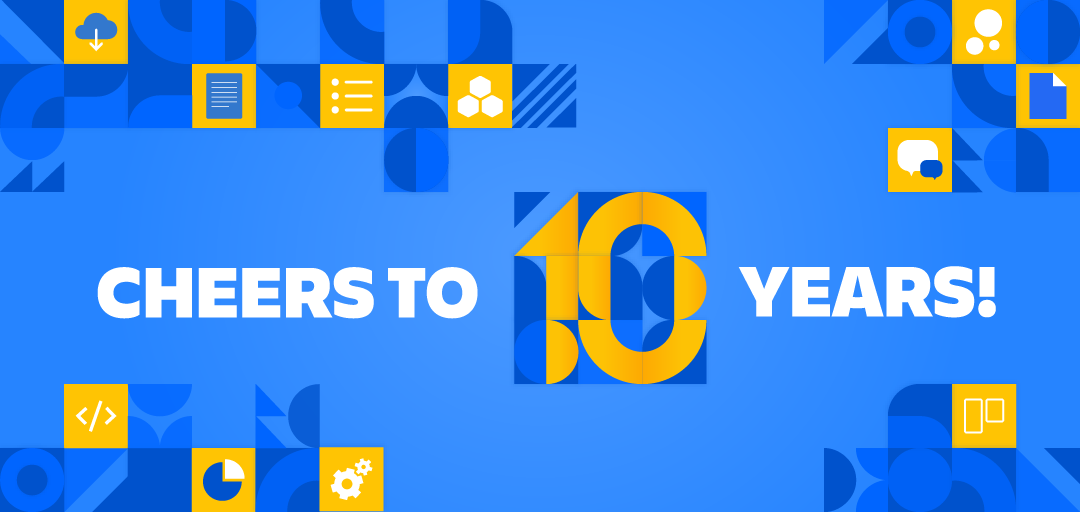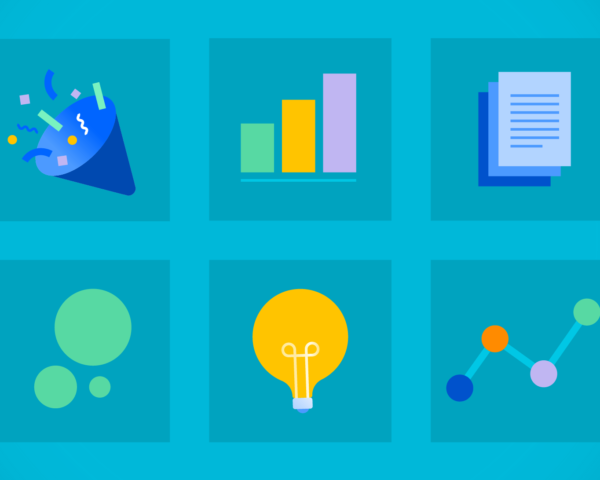celebrate with us
We’re excited to celebrate 10 years of innovation on the Atlassian Marketplace on May 31, 2022! To celebrate our birthday, we’re giving back to the next generation of developers by donating $5 for every app installed on the Marketplace on May 31st to Raspberry Pi.
From the earliest days of Atlassian, we’ve understood the importance of customization for enabling teamwork. Each individual is unique, and they make up equally unique teams that need tailored tools to power their planning, collaboration, ideation, and daily work. When it comes to a flexible, customized digital workspace, single products can only go so far – they also need ecosystems to fill in the gaps and extend possibilities for teams.
Lucky for us, Atlassian’s teamwork-enhancing powers have exponentially expanded thanks to a creative and dedicated developer ecosystem. Customers can find apps for everything from navigation and custom fields to OKR tracking and test management on the Atlassian Marketplace.
The Atlassian Marketplace officially launched at our annual user conference (then called Summit – now, Team) in May 2012. It began with only 60 apps for sale from a handful of innovative Marketplace Partners. Since then, they have added thousands more apps and integrations, and in December 2021, we saw Marketplace Partners reach an exciting milestone – over $2 billion in lifetime sales on the Marketplace. Today, it has over 5,300 apps and integrations from 1,250+ Marketplace Partners, and customers install an average of 28,000 apps a week!
The last 10 years have seen tremendous growth, innovation, and dedication from our developer and Marketplace Partner community, all in support of stronger app-powered teamwork. So, there’s no better way to celebrate than to reflect with our Marketplace Partners who’ve been with us since the beginning!
Here’s what they had to say about the most valuable teamwork lessons they’ve learned over the past 10 years.
What has been the biggest change to how your team works since your company was founded?
For many partners, the past 10 years have provided time to hone business strategies and increase efficiency. Moving to cloud has been an exciting opportunity to adjust their ways of working and thinking about app delivery and support.
“The move to cloud required that we change the way we thought about delivering products. With cloud, the product is now a service that needs to be run and maintained. Our agile teams adopted DevOps principles and practices, and the business as a whole needed to start thinking about success in new ways with subscription billing.
Cloud brings with it huge advantages in terms of fast feedback on new features, better customer service (we can see and fix problems before customers even notice) as well as challenges from the need to keep a service up and running 24/7. Our teams also had to learn about customers and their problems in the cloud, including the differences from Server/DC, adapting to these changes brings new thinking and ways of working.”
– Jon Mort, CTO at Adaptavist
“We’ve increased the velocity and quality of the features we deliver by reducing the scope. This allows for quicker value to users with fewer errors.”
– Gorka Puente, Principal Product Manager at Appfire
Many partners have also seen significant growth over the past 10 years, which has changed the way their business operates and forced them to rethink their teamwork strategies and principles.
“At the beginning, I was the sole founder of the company and I had to do everything by myself. Now, we are a team of 25 people. When the team grows, one of the hardest things is to delegate tasks and responsibilities. One of our guiding principles is “Manager of one” – everyone is responsible for setting their individual goals, daily priorities, and achieving results. The biggest change is that now most of the daily activities of our company are done without my involvement and I am proud to see how my colleagues are performing.”
– Raimonds Simanovskis, Founder and CEO at eazyBI
“We’ve seen tremendous growth of the Zendesk Marketplace to over 1,400 apps and integrations today, from partners in every region, and with this ecosystem maturity, the tech alliances team has grown significantly, too. We are now a global team of over 20 and have really embraced remote digital working across multiple timezones, a major change from being a small tightly-knit team sitting together in San Francisco in the early days!”
– Tim Marsden, Senior Director, Technology Partner Ecosystem at Zendesk
What’s the most useful app you’ve installed in Jira or Confluence to help your team work better together?
Of course, our partners all use and find great value in their own apps, but our ecosystem is a community of partners enhancing productivity for one another as well as themselves. Apps that have helped our partners thrive over the past 10 years run the gamut from apps for reporting and public documentation, to automation, story mapping, and project management.
“Of course, we use eazyBI by ourselves to analyze our Jira Software development projects, our Confluence documentation space usage statistics, customer support conversations from HelpScout, as well as Atlassian Marketplace sales and license data. From other partners’ apps, I would like to mention Scroll Viewport by K15t that we use to create a nice and clean public view of our documentation site docs.eazybi.com.”
– Raimonds Simanovskis, Founder and CEO, eazyBI
“We have a number of tools that we use on a daily basis. To pick one would be difficult! We use our Jira Command Line Interface and Confluence Command Line Interface to automate nearly every task possible. We also use Whiteboards for Jira and Whiteboards for Confluence to collaborate during planning sessions, retrospectives, and design discussions. And there’s Time to SLA to help support teams manage customer SLAs based on statuses and custom dates, and Canned Responses. Since we are a growing team, BigPicture is used for planning. And Jira Misc Workflow Extensions is used for automating our many different workflows.”
– Jeff Pierce, SVP of Product Engineering at Appfire (and Bob Swift before Appfire)
“We installed Agile Story Map to help us visualize each task within the bigger framework of our roadmap for the company so that we can provide executives with a holistic view of the product roadmap feature updates and status. We also utilize Jenkins Integration to help our Project Managers to track every Migration Pipeline, create traceability for all work items, and fulfill compliance requirements for enterprises. Jenkins Integration helps our Project Managers check logs and troubleshoot errors faster.”
– Sudhindra Rao, Development Manager for Partners at JFrog
What’s the most important team ritual you’ve established over the last 10 years?
“Team ritual” can mean a lot of things, so we were interested to hear what regular activities and practices partners have established over the past decade. For some, the most important rituals are the ones that bring the team together on a personal level.
“Connecting with others on a personal level. Truly getting to know the team via formal team offsites, dinners, coffee, or no-work meetings. Bringing your whole self to work and making time for each other is key to interacting and working effectively as a team.”
– Tim Marsden, Senior Director, Technology Partner Ecosystem at Zendesk
Others stress the importance of knowledge sharing and reflection to ensure that teams are always improving.
“Building in feedback loops so that teams have the information that they need to improve and serve customers better. Taking time to reflect is a great way to go faster and deliver more value.”
– Jon Mort, CTO at Adaptavist
“I believe the most important ritual for our team is having retrospective meetings throughout the lifecycle of the project. Unlike post-mortems, retrospective meetings happen every couple of weeks and are meant to deliver continuous improvement amongst the team – similar to the CI/CD activities in software development. Every piece of feedback shared during a retrospective helps the team improve our future strategies, approach, processes for better collaboration and outcomes the next time around.
Oftentimes during a project the course we’re taking or the project requirements change somewhere along the way. So, it’s good to hold a mirror up and keep ourselves accountable for what prompted that course correction – was it a change in scope or something we learned along the way that caused us to revise our strategy, or solving for an error made? By having each team member share what they feel worked and what didn’t, we can learn from each others’ successes and incorporate some of those strategies into our own routine when possible.”
– Sudhindra Rao, Development Manager for Partners at JFrog
What was the biggest mistake you made over the past 10 years when it comes to your team’s structure or workflows? How did you correct it?
No team is perfect, and we can all learn from one another by reflecting on practices that don’t serve our teams. For some partners, the greatest challenges over the past decade have been solved by a shift in team culture.
“[Our biggest mistake was] looking at the team from an org chart perspective rather than a personal perspective. Realising how important getting to know your team on a personal level is, to understand their individual motivations, ambitions and personalities, and then how they can contribute towards the organisation is so key to an effective and happy team.”
– Tim Marsden – Senior Director, Technology Partner Ecosystem at Zendesk
For others, the most notable teamwork challenges arose in pursuit of efficiency and were resolved by taking a step back to evaluate their overall approach.
“We have spent a lot of time and effort to modernize and automate build and deployment processes for our products. Gliffy used to create a lot of custom tooling and we’ve been replacing that by adopting more off-the-shelf tools.”
– Nate Pendleton, Software Architect at Gliffy
“A frequent mistake I see teams making is neglecting to work on our ways of working. By that, I mean sticking with best practices, not paying off technical debt quick enough, and not taking the time to explore new tools and new team structures. This comes from a good place, the desire to ship features to customers, but ultimately is a false economy.”
– Jon Mort, CTO, Adaptavist
How have you kept your team motivated and connected over the past 10 years, even during tough times?
The past few years have been a challenge for teams across the globe. Many partners have been forced to find new ways to keep their teams connected and motivated through remote social gatherings or shared values.
“We have been working remotely all the time since the founding of the company. Therefore, lock-downs during the pandemic didn’t affect our daily work so much. However, we still missed our on-site meetings and parties… One year we did a fully remote Christmas party where we still managed to organize common fun activities and had festivities with sweets, champagne, and speeches, while in the second year, we met in the forest and had a real winter wonderland party. Still, the most important is transparency – everyone can share how they feel about these tough times and get support from others.”
– Raimonds Simanovskis, Founder and CEO, eazyBI
“This has changed a lot in the past few years – we used to do Thursday happy hours called “Gliffiesta” in our office. Now, as our team has grown and expanded internationally in the past 2 years, we’re informally testing the best ways to connect.”
– Nate Pendleton, Software Architect at Gliffy
“At Appfire we have a set of core values that was driven by one of our founders, Mat Gauvin. We try very hard to stay true to these values and apply them. This starts at the top and can be felt throughout the organization. For example, we recently hired someone dedicated to our philanthropic initiatives, and our support of Pledge 1% is something I’m incredibly proud of. Living our core values through the pandemic and now the Ukraine war keeps us all motivated.”
– Jeff Pierce, SVP of Product Engineering at Appfire (and Bob Swift before Appfire)
What new teamwork strategies do you hope to explore over the next 10 years?
With the first decade of the Atlassian Marketplace coming to a close, it’s time to look into the future. Over the next decade, partners are excited to find better ways to collaborate and create healthy teams and work practices remotely and asynchronously.
“With our team split mostly between the West Coast and Estonia, we can definitely improve our asynchronous communication and planning skills to work more efficiently. I’m also really interested in implementing more automated workflows so that the team can shift more of their focus from recurring tasks to building an awesome diagramming experience.”
– Nate Pendleton, Software Architect at Gliffy
“Lead by example when it comes to work-life balance. Give more responsibility to teams, even if it means we slow down processes a bit. Establish more team traditions (like our traditional Friday gatherings).”
– Gorka Puente, Principal Product Manager at Appfire
“I’d like to further explore how to connect teams when they are remote to keep them as engaged as when they are in the office. There are a lot of technologies out there that claim to help do this, but I think it’s not just about the platform you use, but the culture, and process you build around the use of those technologies – just like DevOps.”
– Sudhindra Rao, Development Manager for Partners at JFrog
Over the first decade of the Atlassian Marketplace, Marketplace Partners have contributed thousands of apps, lessons, and insights to help us all work better together. Thanks to Gliffy, JFrog, Zendesk, Appfire, EazyBI, and Adaptavist for sharing their lessons, and thank you to all of our partners and developers for making the last 10 years so inspiring!
Reminder: For every app installed on May 31st, Atlassian will give $5 to Raspberry Pi to support the next generation of developers.



